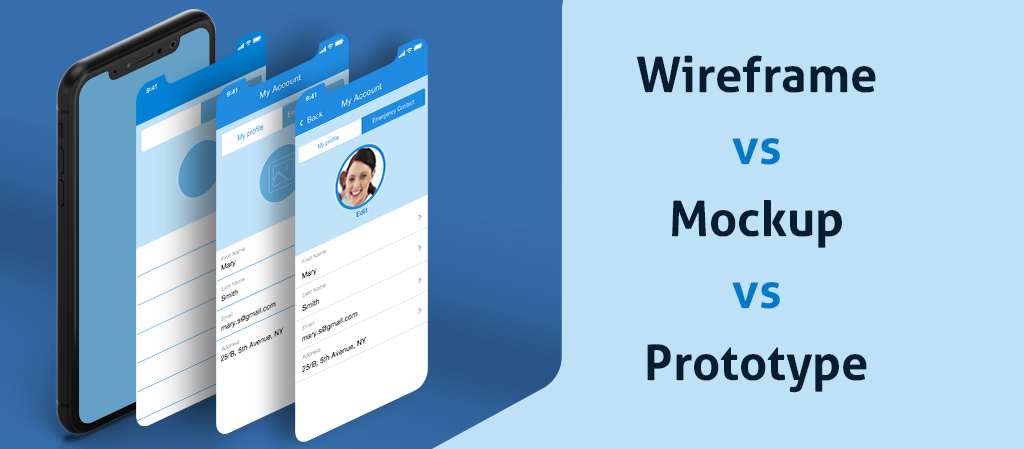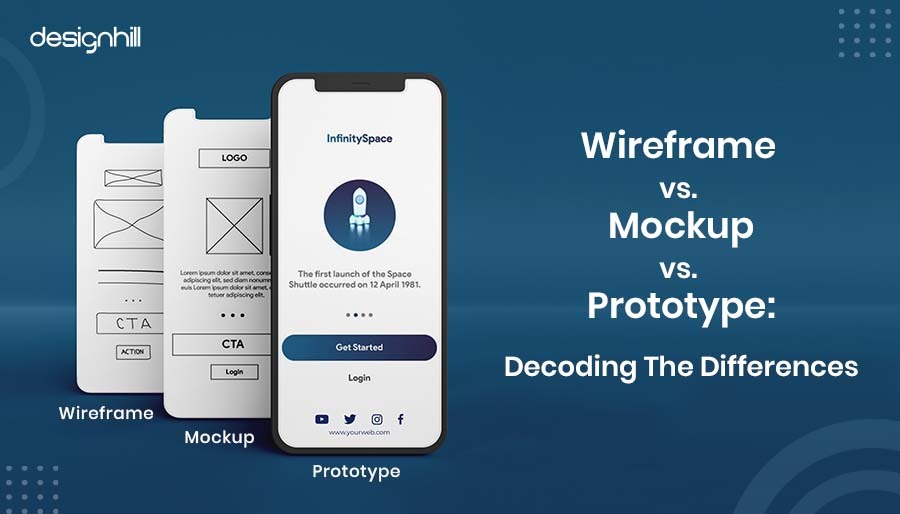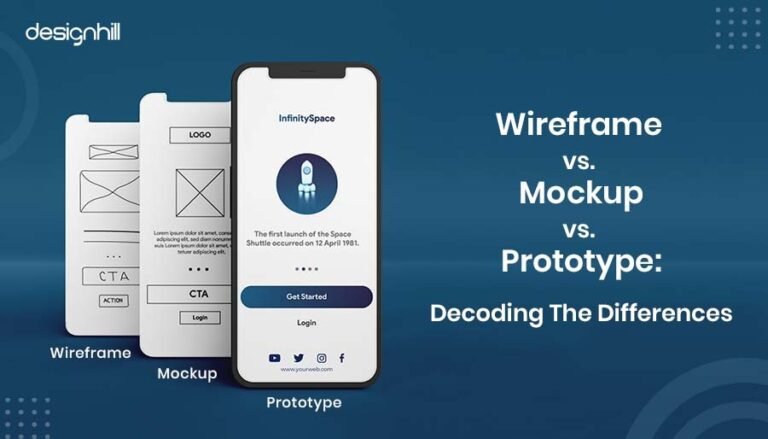In the world of design, wireframes, mockups, and prototypes play key roles. Each has a unique purpose and process.
Understanding the differences between wireframes, mockups, and prototypes is crucial. Designers use these tools to visualize, test, and refine ideas. But what sets them apart? A wireframe outlines the basic structure. A mockup adds visual details. A prototype allows users to interact with the design.
Each step brings a project closer to reality. Knowing when and how to use each tool can save time and improve results. This blog will help you decode the differences, making your design process smoother and more effective. Dive in to learn how each tool can benefit your next project.
What Is A Wireframe?
A wireframe is a basic visual guide that shows the structure and layout of a web page or app. It focuses on content placement and functionality without design details.
A wireframe is an essential part of the design process. It serves as a blueprint for the structure of a website or app. By outlining the basic elements, it helps designers plan the layout before diving into details.Definition
A wireframe is a simple, visual guide. It represents the skeletal framework of a digital product. It focuses on layout and content placement. It does not include colors, images, or detailed styling. Think of it as the foundation of a building.Characteristics
Wireframes are usually black and white. They use simple shapes like boxes and lines. They lack detailed design elements. Their purpose is to show structure and functionality. Wireframes help teams agree on basic layouts. They are quick and easy to create. They save time in the early design stages.Common Tools
Several tools can create wireframes. Popular choices include Balsamiq, Sketch, and Adobe XD. Each tool offers unique features. Balsamiq is known for its simplicity. Sketch provides advanced vector editing. Adobe XD integrates well with other Adobe products. These tools help designers visualize and communicate ideas effectively. “`
Credit: www.ailoitte.com
What Is A Mockup?
Understanding the difference between wireframes, mockups, and prototypes is crucial for web and app design. Each serves a unique purpose. Here, we focus on mockups. They bridge the gap between wireframes and prototypes. A mockup offers a visual representation of your product.
Definition
A mockup is a static, high-fidelity design representation. It showcases the layout, color schemes, typography, and other visual elements. Unlike wireframes, mockups provide a detailed visual of the final product. They do not include any interactive elements.
Characteristics
Mockups are detailed and visually rich. They include colors, fonts, images, and branding. They help stakeholders visualize the final product. Mockups focus on the look and feel of the design. They do not show functionality or user interactions.
Common Tools
Several tools help create mockups. Popular options include Adobe XD, Sketch, and Figma. These tools offer various templates and design elements. They enable designers to create detailed and visually appealing mockups. Each tool has unique features to suit different design needs.
What Is A Prototype?
Prototypes are crucial in the design process. They bring ideas to life. They help visualize the final product. Prototypes are interactive models of a product. They showcase its functionality and user experience. By building a prototype, designers can test and refine their concepts. This stage helps identify any flaws early. Let’s dive deeper into prototypes.
Definition
A prototype is an early sample of a product. It is a working model that demonstrates the product’s core features. Prototypes are often used to test ideas. They help understand how users will interact with the final product. Prototypes can be physical or digital. They bridge the gap between concept and reality.
Characteristics
Prototypes have several key traits. They are interactive and functional. They focus on usability and user experience. Prototypes include basic design elements. They are not fully polished but provide a clear idea of the final product. Feedback is vital at this stage. It helps refine the design before full development.
Common Tools
Several tools can help create prototypes. Sketch is popular for its ease of use. Adobe XD offers robust features. Figma allows for real-time collaboration. InVision is great for clickable prototypes. Each tool has unique strengths. Choose one that fits your needs and workflow.

Credit: colab.research.google.com
Key Differences
Understanding the differences between wireframes, mockups, and prototypes is essential for any web or app design project. Each serves a unique purpose and is used at different stages of the design process. In this section, we will explore the key differences among them in a clear and concise manner.
Wireframe Vs. Mockup
A wireframe is a basic, visual guide used to suggest the structure of a website or app. It includes simple shapes and lines to represent elements such as navigation, content areas, and interface components. Wireframes are typically black and white.
Mockups, on the other hand, are more detailed and visually rich. They include colors, fonts, and imagery to represent the final design. While a wireframe focuses on structure and layout, a mockup brings the design closer to the final product. This makes it easier for stakeholders to visualize the end result.
| Aspect | Wireframe | Mockup |
|---|---|---|
| Purpose | Structure and layout | Visual design |
| Detail Level | Basic | High |
| Color | Black and white | Full color |
| Interactivity | None | None |
Mockup Vs. Prototype
Mockups and prototypes both provide a more detailed view of the final product. Yet, they serve different purposes. A mockup is a static representation, showing how the final product will look. It does not include any interactive elements.
A prototype goes a step further. It includes interactive features and simulates user interactions. This allows designers to test functionality, user flow, and usability. Prototypes are crucial for identifying potential issues before development begins.
- Mockup: Visual design, static, non-interactive.
- Prototype: Interactive, simulates user experience, tests functionality.
Wireframe Vs. Prototype
Wireframes and prototypes differ significantly in their level of detail and interactivity. A wireframe provides a basic outline, focusing on the layout and structure. It is a blueprint for the design, with no visual details or interactive elements.
Prototypes, in contrast, are highly detailed and interactive. They mimic the user experience and include clickable elements. Prototypes help designers and stakeholders understand how the product will function and feel.
- Wireframe: Basic layout, no interactivity.
- Prototype: Detailed, interactive, mimics user experience.
When To Use Wireframes
Wireframes are essential in the early stages of a design project. They help in planning and organizing content and functionality. Wireframes act as a blueprint for your project, laying the groundwork for more detailed designs.
Ideal Scenarios
Wireframes work best during the brainstorming phase. They help visualize ideas quickly. This makes it easier to discuss and make changes. They are useful when defining the basic structure of a page or app. This includes the placement of elements like headers, footers, and navigation menus. Wireframes are also ideal when you need to gather feedback from stakeholders. They provide a clear, simple visual that everyone can understand.
Benefits
Wireframes offer several advantages. They save time and resources by catching design issues early. This means fewer revisions later. They help focus on user experience. By emphasizing functionality over aesthetics, wireframes ensure that the design meets user needs. They also facilitate clear communication among team members. Everyone gets a shared vision of the project. Lastly, wireframes help in prioritizing content. By visualizing the layout, you can decide what content is most important and where it should go.

Credit: www.designhill.com
When To Use Mockups
Understanding the differences between wireframes, mockups, and prototypes can be tricky. Knowing when to use each can greatly improve your design process. In this section, we focus on When to Use Mockups.
Ideal Scenarios
Mockups are best for scenarios where you need to visualize the final product. They offer a detailed and static representation of your design.
- Presenting design ideas to stakeholders: Mockups help stakeholders understand the design’s visual aspects.
- Design reviews: Use mockups to gather feedback on visual elements.
- Marketing materials: Create realistic images for marketing and promotional content.
Benefits
Using mockups offers several benefits:
- High visual fidelity: Mockups show detailed colors, typography, and layout.
- Easy to understand: They provide a clear picture of the final product.
- Effective communication tool: Mockups bridge the gap between designers and non-technical stakeholders.
| Scenario | Why Use Mockups |
|---|---|
| Design Presentation | Showcase visual elements to stakeholders. |
| Feedback Sessions | Gather input on visual design components. |
| Marketing | Create realistic visuals for promotional use. |
When To Use Prototypes
Prototypes play a crucial role in the design process. They help transform ideas into tangible products. Understanding when to use prototypes can save time and resources. Let’s delve into the ideal scenarios and benefits of using prototypes.
Ideal Scenarios
Prototypes are essential in several situations. Here are some ideal scenarios:
- Testing User Interactions: Prototypes allow designers to test user flows and interactions.
- Gathering Feedback: Early feedback helps refine the design before final development.
- Validating Ideas: Visual representation of ideas aids in validating concepts with stakeholders.
- Demonstrating Functionality: Prototypes showcase how the final product will function.
Benefits
Using prototypes offers several benefits. Let’s explore some key advantages:
- Cost-Effective: Identifying issues early reduces the cost of development.
- Improved Communication: Visual prototypes improve communication between team members and stakeholders.
- User-Centered Design: Prototypes help focus on user needs and improve user experience.
- Faster Iterations: Prototypes enable quick iterations and refinements.
| Scenario | Benefit |
|---|---|
| Testing User Interactions | Improves user flow |
| Gathering Feedback | Refines design |
| Validating Ideas | Aids stakeholder approval |
| Demonstrating Functionality | Shows product function |
Frequently Asked Questions
What Is A Wireframe In Design?
A wireframe is a basic visual guide that represents the skeletal structure of a website or app. It outlines the layout, content arrangement, and navigation.
How Does A Mockup Differ From A Wireframe?
A mockup is a high-fidelity static design that includes visual elements like colors, typography, and images. Unlike wireframes, it focuses on aesthetics.
What Is The Purpose Of A Prototype?
A prototype is an interactive and functional model of a product. It allows testing of user interactions, usability, and flow before final development.
When Should You Use A Wireframe?
Use a wireframe during the early stages of design. It helps to plan the layout and structure without distraction from visual details.
Conclusion
Understanding wireframes, mockups, and prototypes is crucial for effective design. Wireframes outline basic structure. Mockups add visual details. Prototypes simulate user interaction. Each tool serves a unique purpose. Choose based on your project’s needs. Clear communication with your team improves results.
Effective design saves time and resources. Make informed decisions. Enhance user experience. Keep refining your skills. Happy designing!
